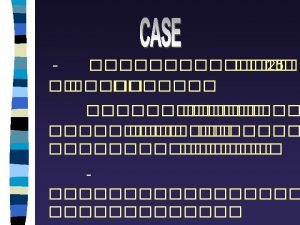David Sadava David M Hillis H Craig Heller

























- Slides: 25


David Sadava, David M. Hillis, H. Craig Heller, May R. Berenbaum La nuova biologia. blu Anatomia e fisiologia dei viventi S

Salt and Water Balance and Nitrogen Excretion

How Does the Mammalian Excretory System Work? Maintaining homeostasis of the extracellular fluid is the job of the excretory system. Excretory systems control volume, concentration, and composition of the extracellular fluid, and excrete wastes. • Kidney—the main excretory organ • Nephron—the main functional unit of the kidney.

How Is the Mammalian Kidney Made? Kidneys filter blood and produce urine. Ureter—a duct from the kidney that leads to the urinary bladder. Urethra—a tube for urine excretion leading from the urinary bladder where urine is stored to the outside of the body. The ureter, renal artery, and renal vein enter the kidney on the concave side. The ureter branches and envelops the renal pyramids.

The Human Excretory System Renal pyramids make up the medulla, or internal core. The cortex is the outer layer of the kidney.

How Is the Mammalian Kidney Made? Organization of nephrons: • Glomeruli and Bowman’s capsules are located in the cortex • Proximal convoluted tubules—the initial, twisted segments of the renal tubules, are in the cortex • The renal tubule descends into the medulla and forms the loop of Henle which is important for urine concentration. After forming the loop, the tubule returns to the cortex. • The ascending limb of the loop of Henle becomes the distal convoluted tubule.

How Is the Mammalian Kidney Made? The Bowman’s capsule encloses the glomerulus. Podocytes are capsule cells that contact the glomerular capillaries. Podocytes have fine processes that wrap around and interdigitate with the capillaries.

How Is the Mammalian Kidney Made? The distal convoluted tubules join the collecting duct in the cortex. Collecting ducts descend through renal pyramids and empty into the funnel-shaped pelvis. These join together and leave the kidney as the ureter.

How Is the Mammalian Kidney Made? Blood vessel organization in the kidney parallels that of the nephrons. Blood enters the glomerular capillaries via an afferent arteriole and leaves in an efferent arteriole. Blood then enters another capillary bed, the peritubular capillaries surrounding the renal tubules. All peritubular capillaries from a nephron join into venules that lead to the renal vein.

How Does the Mammalian Kidney Produce Concentrated Urine? Urine formation in vertebrate nephrons involves three processes: • Filtration—blood is filtered in the glomerulus • Tubular reabsorption—glomerular filtrate flows into the renal tubule, where it is modified by reabsorption of specific ions, nutrients, and water. • Tubular secretion—tubule cells transport substances to be excreted into the glomerular filtrate.

The Vertebrate Nephron

How Does the Mammalian Kidney Produce Concentrated Urine? Mammals product urine that is more concentrated than the extracellular fluid. This is due to a countercurrent multiplier mechanism in the loops of Henle. Tubule fluid flows in opposite directions in the ascending and descending limbs. A solute concentration gradient is created in the renal medulla.

Concentrating the Urine

How Does the Mammalian Kidney Produce Concentrated Urine? The vasa recta is a network of peritubular capillaries parallel to the loops of Henle and the collecting duct. Fluid passing down the renal tubule changes composition through reabsorption and secretion by tubule cells. Because of the actions of the renal tubules, the excreted urine is very different from the original filtrate.

How Does the Mammalian Kidney Produce Concentrated Urine? Kidneys also regulate p. H of extracellular fluids. HCO 3– ions are the major buffers in blood.

How Are Kidney Functions Regulated? A constant glomerular filtration rate (GFR) requires that blood is supplied to the kidneys under adequate pressure. If GFR falls, kidney releases the enzyme renin, which activates angiotensin. Angiotensin constricts efferent renal arterioles and peripheral blood vessels all over body to raise blood pressure.

How Are Kidney Functions Regulated? Angiotensin stimulates adrenal cortex to release aldosterone.

How Are Kidney Functions Regulated? The hypothalamus can stimulate release of antidiuretic hormone (ADH), or vasopressin, from the posterior pituitary. ADH acts on collecting duct cells to insert aquaporins and increase permeability to water. Osmoreceptors and stretch receptors can stimulate ADH release.

What Are the Major Diseases? Renal failure results in: • Salt and water retention (high blood pressure) • Urea retention (uremic poisoning) • Decreasing p. H (acidosis) Dialysis treatment passes blood through membrane channels bathed in a plasma-like solution to remove wastes.

How Do Animals Excrete Nitrogen? Animals must eliminate metabolic waste products. Ammonia (NH 3) is the most common nitrogenous waste. It is toxic and must be excreted continuously or converted.

How Do Invertebrate Excretory Systems Work? Invertebrates have a variety of mechanisms to maintain salt and water balance and excrete nitrogen. • Protonephridia (Planaria) • In annelids, each segment contains a coelom (body cavity) and a pair of metanephridia.

How Do Vertebrates Excretory Systems Work? • Insect excretory systems consist of Malpighian tubules —blind-ended tubules that open into the gut. • Amphibians in dry environments reduce permeability of their skin to water. Estivation is a state of low metabolic activity and low water turnover. • Marine fishes must conserve water in their high osmolarity environment.

How Do Vertebrates Excretory Systems Work? • Reptiles have three major adaptations that allow them to exist in dry regions: o Internal fertilization and shelled eggs o Dry epidermis that retards water loss o Excretion of nitrogenous wastes as uric acid, with little water loss.

Adapted from Life: The Science of Biology, Tenth Edition, Sinauer Associates, Sunderland, MA, 2014 Inc. All rights reserved
 David sadava
David sadava Mueller hillis maneuver
Mueller hillis maneuver Craig heller
Craig heller Heller h 4000
Heller h 4000 Léo heller
Léo heller Heller zsolt
Heller zsolt Ultrageneralizacion heller
Ultrageneralizacion heller Noah heller
Noah heller Matthieu heller
Matthieu heller Lex rogata
Lex rogata Annette heller
Annette heller Herman heller
Herman heller Desiree heller
Desiree heller Heller fundraising group
Heller fundraising group Katherine heller duke
Katherine heller duke Anterior fundoplication
Anterior fundoplication Greyheller mobile
Greyheller mobile Grunnisolasjon
Grunnisolasjon Craig greenwood liverpool
Craig greenwood liverpool Buried penis
Buried penis Fedmall login
Fedmall login Design patterns slides
Design patterns slides Stephanie craig rushing
Stephanie craig rushing Deegan financial accounting theory
Deegan financial accounting theory Craig kohn
Craig kohn Ids craig
Ids craig















































